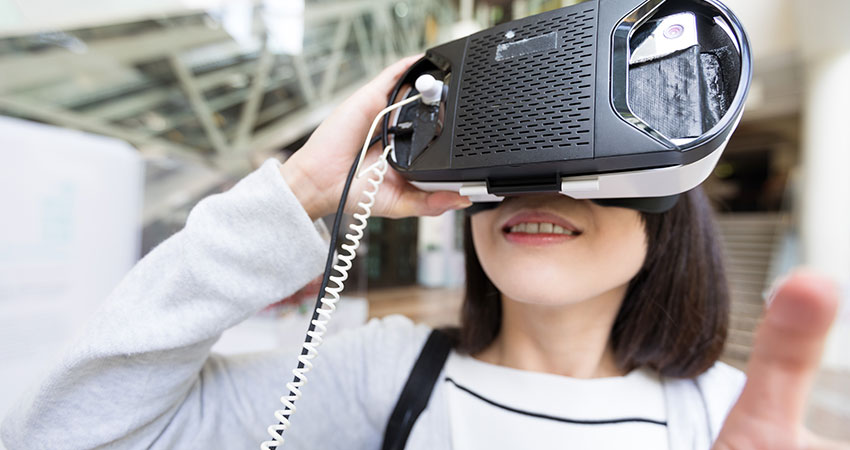The pandemic and global economic lockdowns have rocked the retail industry. But there are two major changes that will have lasting effects on post-COVID retail:
- With the closure of physical stores, we are getting used to shopping online in a more serious way.
- We’ve become afraid of public spaces.
Picture this: The world has re-opened, at least partially, and it’s time to replace the sofa that became a kid’s jungle gym during shelter in place. You walk into a shopping area full of people with everyone sitting, lying and bouncing on the display sofas. Suddenly, this doesn’t sound so good anymore, does it?
At the same time, making a big purchase online leaves a lot to be desired. How do you know what it feels like? How does it make you feel? For retailers, how do you insert the human interaction and experience of an effective salesperson? Can you qualify a purchaser’s intent before removing the protective coating knowing that you now have to sanitize that item (or discard it) if not purchased?
What’s Next? The Blended Shopping Experience
Now imagine a post-COVID retail future with a blended private shopping experience, where you can look for, select and configure products from your favorite brands online. AR lets you see that item in context: Makeup on your face, a sofa in your living room or jeans on your legs. You can have smaller items shipped to do a “try before you buy” or book an appointment at a showroom, but the future showroom will look and feel quite different.
Large open retail spaces have been converted into stylish VR-enabled booths with a salesperson nearby (and not wearing a mask in VR) to help. Once you’ve selected items, a deposit needs to be authorized to see the product; you can still return it, but to keep prices under control and the next customer safe, it needs to be sanitized. Enjoy the VR world while the items are brought to you for a hands-on test before purchase.
This post-COVID retail experience may seem space-aged at first, passing through the temperature sensor and ambling by the ultraviolet sanitizing booth, but ultimately, it’s the way retailers can build trust. In the new normal, people will pay close attention to cleaning protocol, but consumers will always value experience.
Going 3D to Help Reignite Consumer Spending
In order to evolve the at home shopping experience into the store of the future, we need to go 3D.
First up is scanning. Whether it’s makeup or sofas placed in the living room, sensors in or attached to the phone need to capture a 3D map. Apple has been leading the charge by upgrading cameras starting with iPhone X TrueDepth, and more recently with the mobile LiDAR camera on the new iPad Pro. These “time of flight” cameras understand depth of the space by measuring the speed of photons reflecting off surfaces meters away.
Next is to build, manage and render 3D objects. Unlike 2D image formats, 3D models are heavy, complex and today there’s no consistent standard. Getting into the gobbledygook, many in the industry are leaning towards an open format called .gltf while Apple is pushing its own version, .usdz. This doesn’t sound like it will enter the common conversation the way GIF has, but for a tool ecosystem to thrive and merchandisers to digitally model that couch, there needs to be an agreement upon format.
Visual merchandisers and store planners will also need to create beautiful and flexible 3D models of products and any augmentation to the environment. Developing in 3D is not new: Architecture, design, game development and film visual effects have been do so for decades, and we have good tools such as Unity MARS and Adobe Aero. But now, retailers need to be able to work in these tools.
On the other side, online store designers, who today are working in Shopify or SquareSpace, will need 3D modeling tools to lay out their shopping experience and translate it into AR/VR. You can imagine a whole new type of agency focused on making your 3D shopping environments sing.
If you own an AR/VR headset, you can make your shopping more immersive. But let’s say you want to leave the house and touch that Taycan, or your dog ate your Oculus. The in-store experience will blend a new “third space” with the virtual world. We’ll need software solutions leveraging sophisticated cameras to enable the positioning and rendering of 2D and 3D objects in the physical world in a way that makes them look realistic including depth ratio, light and shadow and occlusion.
Imagine walking onto the set for the latest Anthropologie catalog shoot but there’s a green screen in the middle where your couch is on display. Put on new Air Jordans in MJ’s living room. Try out that Dewalt grinder in the “American Choppers” workshop. Sit on the barstool in Beyoncé’s kitchen. Like EDM? Skrillex can DJ a set at a beach party in Ibiza while you AR that swimsuit on.
Designing the flexible physical spaces that blend seamlessly with 3D and speak to who we are or want to be – that’s the future of merchandising and it needs a kind of mixing console (a la Ableton Live) but for the sales associate.
The rollout of this type of post-COVID retail experience will likely follow other new technology patterns. First, high-end, technology-forward brands will create bespoke solutions that educate consumers. As the ecosystem evolves, these tools will be available to more stores and simpler integrated solutions from trusted vendors will become available.
In the world of post-COVID retail, there will be real and urgent opportunities to evolve the shopping experience into a safe yet compelling experience in the “new normal” world. Technology companies will build and create the adaptations in retail and commerce necessary to bring consumer spending back.
Issac Roth is a partner with Shasta Ventures

